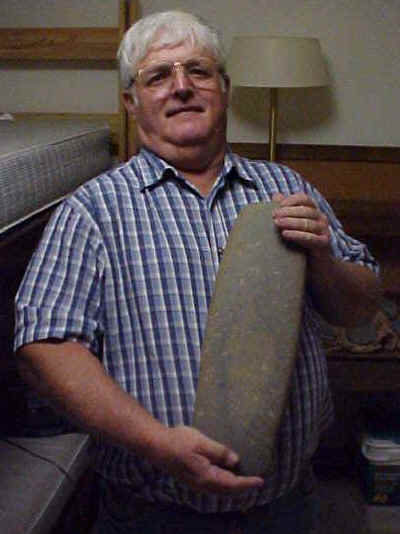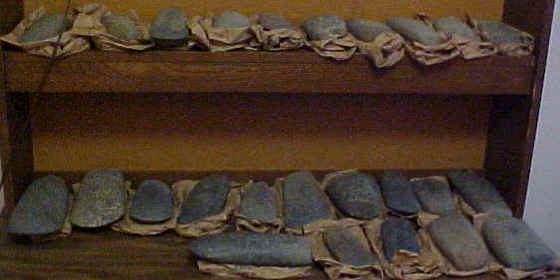|
THE LARGEST DOCUMENTED
CACHE OF ungrooved axes EVER FOUND An important discovery was made on July 13, 2001 by professor Tim Pauketat and his group of archaeology students. Tim is a professor at the University of Illinois's Urbana-Champaign campus. The discovery was made on a Cahokia culture Mississippian village site near O'fallon, Illinois. He is excavating this unique site with funds from a National Science Foundation grant. The discovery was made by student Nick Wisseman who first made contact with what is believed to be the second largest cache of celts (ungrooved axes) ever found in this area. It may be the largest scientifically excavated cache of this type ever found in North America.
This picture shows Larry Kinsella holding the largest celt from the cache of 70. This celt measures 6 inches wide & 18 inches long and weighs 25 pounds. A cache of 70 celts were discovered in a circular pit and tightly packed in layers. The total weight of this cache is more than 250 pounds. The largest axe weights 25 pounds and measures 6 inches wide and 18 inches long. It's believed to be the largest celt ever found in the area. Dr. Pauketat calls it "the mother of all axe heads". Except for three that show possible signs of use all the axes are newly made. Different styles of axes are represented in this cache including the flared bit variety. They were all made of a hard igneous rock called diabase.
ST. CLAIR COUNTY, ILLINOIS UNIVERSITY OF ILLINOIS AT URBANA- CHAMPAIGN ANTHROPOLOGY DEPT. A cache of 100 axes was reportedly found near Cahokia Mounds in the late 1800's but little is known about that find. The current location of only one of those axes is known. Another cache of 50 axes was also found near Alorton, Illinois in the 1940's of which 37 are now in the Illinois State Museum's collection.  PHOTO CREDIT LARRY KINSELLA 12 EXAMPLES FROM THE CACHE OF 70 ST. CLAIR COUNTY, ILLINOIS UNIVERSITY OF ILLINOIS AT URBANA- CHAMPAIGN ANTHROPOLOGY DEPT. This Mississippian site dates to a time just before Cahokia Mounds was reaching its "golden age", about 900 years ago. But it's not typical of other Cahokia culture farming villages in the area. This one has much larger houses that measure about 5 by 9 meters which is twice the size of other houses that have been excavated around Cahokia Mounds. They were also densely packed as close as two feet apart and situated around a courtyard that measured about 90 feet on a side. Another unique find were several large post pits that measured two feet in diameter.
ST. CLAIR COUNTY, ILLINOIS UNIVERSITY OF ILLINOIS AT URBANA- CHAMPAIGN ANTHROPOLOGY DEPT.
|
|
"REFERENCES" August 5,
2001---Madison
County NEWS DEMOCRAT, "The Mother of All Ax Heads", by George
Pawlaczyk. |



